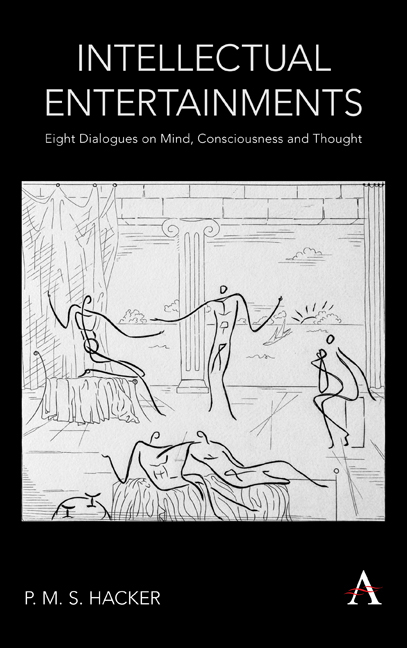Book contents
- Frontmatter
- Dedication
- Contents
- Preface
- Acknowledgements
- Section 1 Two Dialogues on Mind and Body
- Section 2 Two Dialogues on Consciousness
- Section 3 A Dialogue on the Objectivity or Subjectivity of Perceptual Qualities
- Section 4 Two Dialogues on Thought
- Section 5 A Dialogue on Ownership of Pain
- Introduction
Introduction
from Section 5 - A Dialogue on Ownership of Pain
Published online by Cambridge University Press: 06 December 2019
- Frontmatter
- Dedication
- Contents
- Preface
- Acknowledgements
- Section 1 Two Dialogues on Mind and Body
- Section 2 Two Dialogues on Consciousness
- Section 3 A Dialogue on the Objectivity or Subjectivity of Perceptual Qualities
- Section 4 Two Dialogues on Thought
- Section 5 A Dialogue on Ownership of Pain
- Introduction
Summary
The thought that another person might have my pain seems absurd. You can, it seems, have an exactly similar pain to my pain, but you cannot have the very same pain. As the great nineteenth-century logician Gottlob Frege wittily put it, ‘You can't have my pain, and I can't have your sympathy.’ In short, yours is yours and mine is mine – another man's pain is another pain. Peter Strawson, in chapter 3 of Individuals (1959), held that experiences in general (and pains in particular) are privately owned and inalienable. Indeed, they are not merely inalienable, but logically inalienable. I can't give you my pains, and you can't have them, even if you wanted to. Each human being has his own ‘world of consciousness’, as John Stuart Mill said, and only the owner of the world of consciousness can enter it and observe what is there to be found. What is in my world of consciousness cannot be in yours. Nor can it emigrate from my world of consciousness with an entrance visa into yours. Each subject has his own ‘world of consciousness’ to which he has privileged access. For no one can enter the world of another's consciousness. Conscious states, as John Searle has put it, are ontologically subjective. They have a subjective form of existence, for they exist only when they are had by a conscious subject, animal or human. Obviously, there are no pains without sufferers – one cannot find pains floating around the room unowned. Experiences have to have an owner. Every experience is someone's experience. That, it seems, is a profound metaphysical truth.
This, roughly speaking, is what virtually all philosophers have thought. It is, indeed, the natural way to think. But as should be evident from previous dialogues, in philosophy the natural way to think is all too commonly the wrong way to think. The first philosopher, as far as I know, to challenge received wisdom, and these received distinctions, was Wittgenstein. He did so in his great work the Philosophical Investigations, §§253– 54, but with a brevity that makes excessive demands upon his readers.
- Type
- Chapter
- Information
- Intellectual EntertainmentsEight Dialogues on Mind, Consciousness and Thought, pp. 203 - 206Publisher: Anthem PressPrint publication year: 2019



